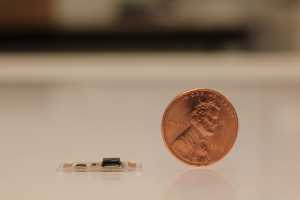21 Nov Tiny Skin-Mounted Sensor Can Monitor Heart, GI and Voice Sounds
MedicalResearch.com Interview with:
YuHao Liu (Howard)
Materials Research Laboratory
University of Illinois
Urbana Champaign
MedicalResearch.com: What is the background for this study? What are the main findings?
Response: Our research group has been working on developing the next-generation wearable technology – integrating electronic tattoos on human skin for healthcare monitoring. This novel platform allows us to explore new sensors and actuators that are better than the commercially available ones.
We have developed sensors that can measure temperature, pressure, hydration, electrophysiology..etc. However, no one ever think about capturing sound from the body until our team developed this new technology. In fact, body sounds can be important indicator in healthcare monitoring or even disease diagnostic.
Our study shows that a thin, light-weight skin-mounted sensor is capable of picking up internal body sounds (cardiovascular, gastrointestinal, voice..etc) via vibration propagating from the source through tissues to the skin. Not only the mechanical signal (i.e. vibration), our sensor platform could also capture electrical signals (i.e. electrophysiology) from the skin.
We demonstrate applications in cardiovascular diagnostic, thrombosis detection of ventricular assisted devices, and classification of human voice for machine controls. These and other possibilities suggest broad-ranging uses for soft, skin-integrated digital technologies that can capture human body acoustics.
MedicalResearch.com: What should readers take away from your report?
Response: Measuring and monitoring all kinds of body sounds using wearable technology is possible and commercialization of this type of devices should be expected in the near future. Applications could range from snore monitoring to heart murmur detection to human-machine interface.
MedicalResearch.com: What recommendations do you have for future research as a result of this study?
Response: At the engineering side, future research should focus on improving the seamless connectivity and wireless powering to improve user experience and reliability.
The concept and the platform are ready for building prototype devices. At the application side, most fundamental studies need to be done on analyzing the vibration spectrum of body sounds, building the databases from a variety group of subjects for future references and machine learning algorithms.
MedicalResearch.com: Is there anything else you would like to add?
Response: Skin wearable is the future for medical and healthcare monitoring!
MedicalResearch.com: Thank you for your contribution to the MedicalResearch.com community.
Citation:
Yuhao Liu et al. Epidermal mechano-acoustic sensing electronics for cardiovascular diagnostics and human-machine interfaces. Science Advances, November 2016
DOI: 10.1126/sciadv.1601185
Note: Content is Not intended as medical advice. Please consult your health care provider regarding your specific medical condition and questions.
More Medical Research Interviews on MedicalResearch.com
[wysija_form id=”5″]
Last Updated on November 21, 2016 by Marie Benz MD FAAD

